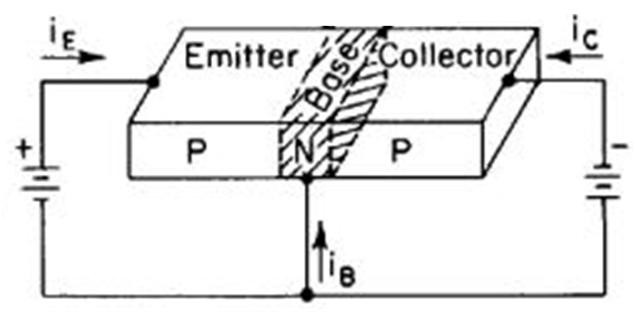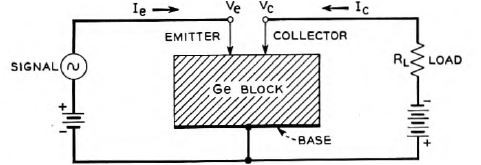Somewhat Off Topic: Deciphering Transistor Terminology
I recently learned something mildly interesting about transistors, so I thought I'd share my new knowledge with you folks. Figure 1 shows a p-n-p transistor comprising a small block of n-type semiconductor sandwiched between two blocks of p-type semiconductor.
The terminology of "emitter" and "collector" seems appropriate, but did you ever wonder why the semiconductor block in the center is called the "base"? The word base seems inappropriate because the definition of the word base is: "the lowest part or edge of something, especially the part on which it rests or is supported."

Figure 1: P-N-P transistor. (Copied without permission from [1].)
Yesterday I was reading an old paper in a Bell System Technical Journal (BSTJ) and discovered why the word base is used for the third terminal of a transistor [2]. In that 1949 paper the authors provided the engineering community the first detailed technical description of their new invention of what was originally called a "semiconductor triode', but was later called a "transistor." Figure 2 shows the paper's circuit description of their revolutionary semiconductor amplifier.
Figure 2: Semiconductor triode. (Copied without permission from [2].)
The semiconductor triode in Figure 2 is very different than our traditional transistor physical description in the above Figure 1. The germanium semiconductor block in Figure 2 is sitting atop a conductive plate called the "base." The BSTJ paper's only description of the base component is, "The base electrode, the third element of the triode, is a large area low resistance contact on the lower face."So there you have it. The third terminal of the semiconductor triode is connected to the metal base on which the triode is supported. Later when William Shockley proposed the more modern-day sandwich arrangement of semiconductor blocks shown in Figure 1, the third terminal's name, base, was retained for historical purposes.
Reference [2], J. Bardeen and W. Brattain's 1949 paper describing their new fangled semiconductor triode, is provided in the PDF file associated with this blog.
Origin of the Word "Transistor"
By the way, the year following J. Bardeen and W. Brattain's invention of their semiconductor triode the administrators at Bell Labs literally took a vote among a group of their scientists to come up with a name for this new device. You can read their voting ballot at:https://www.flickr.com/photos/johngineer/611613734...
A Bit of Transistor Trivia
In 2002 electronic industry analysts, who study such things, estimated there were more transistors produced that year than grains of rice, and the cost of one rice grain could buy 100’s of transistors. Astoundingly, in 2009 analysts estimated there were more than 250 transistors produced for each grain of rice, and the cost of one rice grain could buy 125,000 transistors.
For the Ol' Timers Here On DSPRELATED.COM
One last thing from me regarding transistors; some of the older guys here might remember the 1961 content of the following web page (I do):https://www.youtube.com/watch?v=oMmNUjuKSnA&list=RDoMmNUjuKSnA&start_radio=1&t=16

References
[1] John D. Ryder, "Electronic Fundamentals and Applications", 4th Edition, Prentice Hall Inc., 1970, page. 141.[2] J. Bardeen and W. H. Brattain, "Physical Principles Involved in Transistor Action", Bell System Technical Journal, Vol. 28, No. 2, April, 1949, pp. 239-277. (Also published in the Physical Review, April 15, 1949.) https://www.dsprelated.com/showabstract/3954.php
- Comments
- Write a Comment Select to add a comment

Hello Rick,
I don't remember the song in your youtube link, but I certainly remember this one which was also doing the rounds here in the UK in 1961 . . .
https://www.youtube.com/watch?v=7Y6A0D5jW5k

Hi Woodpecker. That song definitely sounds like something from the mind of Benny Hill.

This is really interesting actually

To post reply to a comment, click on the 'reply' button attached to each comment. To post a new comment (not a reply to a comment) check out the 'Write a Comment' tab at the top of the comments.
Please login (on the right) if you already have an account on this platform.
Otherwise, please use this form to register (free) an join one of the largest online community for Electrical/Embedded/DSP/FPGA/ML engineers:













